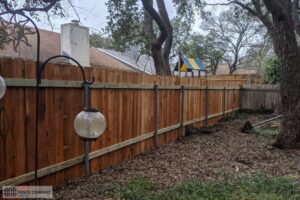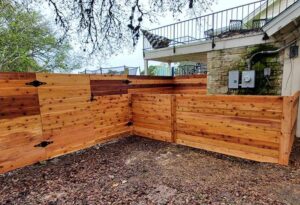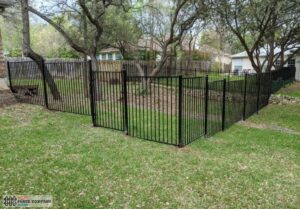Storm Prep & After-Storm Fence Checklist for Central Texas
TL;DR:
Austin storms bring fast wind shifts, driving rain, and hail. Before a system arrives, secure gates, clear vegetation, confirm drainage, and tighten hardware. After the storm, conduct a safe walkthrough (starting with power lines), including a fence inspection. Document the damage with photos, and triage hazards such as leaning posts or open pet egress. For structural issues, prioritize repairs quickly; if failure is widespread, complete replacement can be the cheaper long-term path. If you want a local team that knows our soils, wind paths, and HOA realities, Atlas Fence Company can help you prep and recover.
Table of Contents
ToggleWhy Austin fences fail in storms

Central Texas delivers a familiar cocktail during storm season, which is influenced by Austin’s climate: sudden gust fronts, directional wind shifts, microbursts, and soaked clay soils that let posts rock in their sockets. Common failure points include:
- Shallow or narrow footings that can’t resist push/pull after saturation.
- Gate posts are under extra load from heavy leaves and daily cycles.
- Solid privacy runs that act like sails when the wind hits head-on.
- Unstained wood & exposed end grain, which absorb water and check faster over time.
Different fence materials, such as wood, cedar, vinyl, and metal, each have unique vulnerabilities in Austin’s climate that affect their durability and maintenance needs. Cedar fences, for example, are naturally resistant to rot compared to other woods, but they still require regular staining and maintenance to prevent warping and fading.
Understanding these weak links helps you prevent costly repairs and turns prep from guesswork into targeted action.
UV rays and scorching summer heat can cause damage to fences, such as fading, cracking, and weakening, especially in wood and vinyl fences. Regular maintenance and protective measures can help extend the lifespan of your fence, despite Austin’s challenging weather conditions.
Understanding Fence Components
A well-maintained fence starts with knowing what each part does and how it contributes to your fence’s structural integrity. Whether you have wood fences, metal fences, or chain link fences, understanding the main components helps you spot minor issues before they become costly repairs—especially after severe weather events common in Central Texas.
Key fence components to know:
- Fence Posts: These are the backbone of any fence, anchoring the structure into the ground and supporting the weight of panels or links. Regular fence inspections should focus on checking for leaning posts, wood rot in wooden fences, or rust in metal fence posts. Solid, correctly set posts are essential for keeping your fence upright during high winds and heavy rain.
- Panels or Links: For wood fences and vinyl fences, panels are the sections between posts, made up of pickets or boards. Chain link fences use metal links stretched between posts. Inspect panels for broken boards, loose pickets, or sagging mesh. Addressing these minor repairs early can prevent more expensive repairs down the line.
- Gates: Gates are high-traffic areas that require special attention. Check for sagging gates, misaligned latches, and worn gate hinges. Routine maintenance, like tightening hardware and adjusting gates, ensures smooth operation and keeps your fence secure.
- Hardware: This includes all the fasteners, screws, nails, and brackets that hold your fence together. Loose hardware can lead to rattling panels, safety hazards, and even structural failure. During fence maintenance, look for loose nails, missing screws, and corroded brackets, and replace or tighten as needed.
By understanding how each component works together, Austin homeowners can perform more effective fence inspections, address minor issues promptly, and ensure their fence remains strong and attractive—boosting property value and curb appeal while preventing costly repairs.
Pre-storm checklist (48 hours to go)
Focus on the steps that reduce wind load, water intrusion, and impact damage:
Vegetation & objects
- Trim or tie back vines and branches that can whip the line.
- Move grills, bins, and furniture away from fences; they become battering rams in gusts.
Before storms, homeowners should assess the integrity of their existing fence to ensure it can withstand severe weather.
Gates & hardware for wood fences.
- Verify latch alignment and drop rods fully seat into receivers.
- Tighten hinge bolts; add a temporary strap or cam buckle to keep double leaves from chattering.
- If you have a wide drive gate, park a vehicle inside the yard away from the hinge posts—never use it to brace the leaf.
Drainage
- Clear debris at low spots so water doesn’t pond along the line.
- Ensure mulch isn’t mounded against pickets; it wicks water upward.
Fasteners & loose boards
- Re-set any visibly lifted pickets or rails so wind can’t “grab” them.
- Inspect cap & trim; reseat loose cap segments that could blow off and create water ingress.
Pets
Walk the perimeter and fix gaps now. If something fails later, you’ll know exactly where to place temporary panels.
A comprehensive inspection before storm season can help identify vulnerabilities in your existing fence and ensure the structure’s integrity is maintained.
Day-of actions (when the line is inbound)
- Secure gates closed and drop rods engaged.
- Unlatch automation only if the manufacturer recommends it for high wind; otherwise, leave operator locks engaged and power on.
- Shelter, don’t test. The fence is not the place to be during gust fronts. Stay inside.
First walkthrough after the storm (safety first)
Before you step out:
- Scan for downed power lines and dangling service drops; if present, avoid the area and call your utility.
- Wear gloves and closed-toe shoes; splinters and fasteners will be loose.
On your walk:
- Note any leaning posts (especially at corners and gates).
- Check for racked gate frames, broken latches, and leaves scraping the grade.
- Look for heaved footings (concrete cones protruding) and washed-out soil at the bottoms.
- Confirm pet containment—block escape paths immediately.
- Inspect for broken panels as a sign of urgent storm damage that exposes your property and diminishes the fence’s appearance.
A damaged fence can pose safety risks and compromise the structural integrity of your fence, so address these issues promptly.
If anything looks unstable, keep kids and pets away from that section until it’s braced or repaired to keep your fence safe.
Documentation that helps with claims
Insurers vary, but good documentation is universal:

- Wide, medium, and close photos of each damaged area—include a fixed landmark for scale.
- Angles that show lean at posts (use the house line as a reference).
- Video walkthroughs narrating what happened and when you discovered it.
- Neighbor boundaries: Take photographs of shared lines from both yards (with permission).
- Save receipts for temporary materials (tarps, screws, rental panels) you use to mitigate loss.
You’re not making a legal case here—just building a clear picture of “before and after” that speeds decisions.
Triage: what’s urgent, what can wait
Treat these as urgent:
- Gate won’t latch or close (security risk, pet escape).
- Leaning posts at corners/gates (may pull more sections down).
- Detached sections hanging by a few fasteners.
- Exposed nails/screws at kid or pet height.
- Damage near pools that compromises barriers.
- If you notice significant repairs are needed or there is extensive damage affecting the structure, these situations require professional repair to ensure safety and restore the fence properly.
Usually can wait a beat (but schedule soon):
- Cosmetic picket splits without gaps.
- Minor scuffing or top cap nicking.
- Slight lean in a mid-run post that’s still stable under hand pressure.
For urgent items, schedule professional fence repairs promptly to prevent a minor issue from escalating over time due to wind and foot traffic.
Repair vs. replace: making the call.
Use a simple two-axis test: extent of structural failure and age/condition of the rest of the fence.
- If fewer than ~20–25% of posts are affected and rails/pickets are healthy, targeted repairs make sense.
- If many posts are loose, rails are splitting, or boards are nearing the end of their life, a complete replacement avoids multiple repair visits and restores straight lines.
To accurately assess the extent of damage and determine the best course of action, consider scheduling a professional fence inspection or a professional inspection.
For a deeper decision framework, skim our concise guide on repair vs. replacement so you don’t pour good money after bad. If replacement is likely, we’ll map materials and phasing so you’re secure quickly and pleased with the long-term look. When the repair is done, we’ll focus the scope where it pays off most. Regular maintenance and timely repairs can extend your fence’s life, making replacement less frequent.
Service links for this section: targeted repairs for localized damage, or complete replacement when failure is widespread or the fence is beyond its useful life.
Temporary stabilization until crews arrive
Safety disclaimer: DIY only what you can do without climbing or over-reaching—don’t fight wind with a ladder.
- Brace a leaner: A 2×4 prop to the interior side, foot wedged against a paver, can keep it from progressing.
- Tie off gates: Use a cam strap to a fence post so the leaf doesn’t swing and worsen hinge damage.
- Temporary panels, such as plastic garden mesh or an extra picket run, can close pet gaps until repairs are made.
- Patch small cracks: Apply wood filler to minor cracks or holes in wood fence sections as a temporary fix until permanent repairs are made.
Avoid ad-hoc fixes that force boards out of alignment; you’ll create more work (and cost) later.
Future-proof upgrades for the next storm
When you’re ready to build back better, consider:
- Deeper, wider footings (and bell shapes) at corners and gate posts for clay soils.
- Steel posts with proper caps, especially on long runs and wind-exposed segments.
- Welded gate frames and adjustable hinges to resist sag and allow fine-tuning.
- Board-on-board along street-facing runs to keep seam coverage tight as wood seasons.
- Kick/rot boards to protect pickets from splashback and mower wheels.
- Cap & trim to shed water off the end grain and slow checking.
- Stain wood fences to protect against weathering and extend their durability.
A handful of spec upgrades costs little compared to the repeat repairs that follow the next line of storms.
Complete printable checklist
Before the storm (48–12 hours)

- Trim/tie back vines and branches.
- Clear movable items from the fence line.
- Tighten hinges/latches; engage drop rods.
- Verify drainage; pull mulch off pickets.
- Re-fasten loose boards/caps.
- Walk pets’ perimeter; close small gaps now.
Day-of
- Secure gates closed; operators per manufacturer guidance.
- Shelter indoors.
After the storm, it is crucial to consider fence maintenance to ensure your property remains safe.
- Avoid downed lines; PPE on.
- Photo/video documentation (wide/medium/close).
- Triage: gates, corners, leaners, hanging sections.
- Stabilize safely; schedule pro help.
Regular maintenance keeps your fence in top shape. Remember, a well-maintained fence enhances your home’s curb appeal and value.
Frequently asked questions
Often, but policies vary. Document well, mitigate further damage safely, and contact your carrier for specifics.
If the footing failed or the post is affected by wood rot, a quick shove won’t last. Proper repair typically involves resetting or replacing the post and reconciling rail heights.
Yes. A scraping leaf accelerates hinge wear and can jam during the next wind shift. A quick tune saves a replacement later.
Demand spikes across Austin for a fence company; get on the schedule early. We prioritize safety issues (open yards, pool barriers, gate security) first.
Stronger gate posts/hinges, deeper corner footings, and seam-stable panels (board-on-board) on windward runs.
Routine gate repairs are recommended at least once a year, or whenever you notice issues like sagging, misalignment, or breakage. Regular maintenance ensures smooth operation, prolongs the gate’s life, and maintains security.
Yes, always check local regulations and HOA guidelines before starting any fence repairs. These rules may require permits or specific approvals, and compliance helps you avoid fines or having to redo work.
A well-maintained fence greatly enhances your home’s curb appeal by improving its overall appearance and creating a positive first impression. This can increase property value and contribute to the aesthetic harmony of your home, especially during special occasions or gatherings.
Protect Your Fence Before and After Storms
Need quick repairs after a storm—or want a proactive check before the next one with routine inspections? Our team will inspect your fence, identify potential hazards, and provide you with clear options ranging from targeted fixes to long-term rebuilds. Start by requesting a free fence estimate, and we’ll schedule your service promptly so you can feel confident your fence is ready for any weather.
